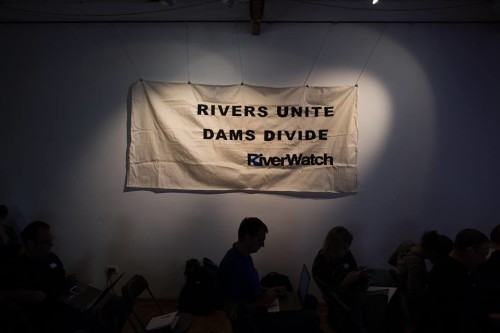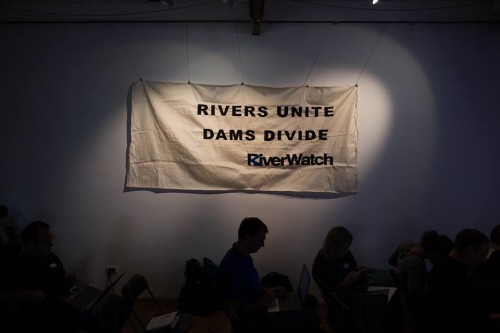By Beogradi, Vera Bekteshi
The news of the last few days regarding the ban on the construction of HPPs on the Radika River, within the Mavrova National Park, is a good sign that the efforts of environmentalists to protect rivers from dams are being supported by the most important European Institutions.
More specifically: on 1.11.2015, the news was published that after the recommendation of the Council of Europe, based in advance on the study of the group of experts of the Berne Convention on the prohibition of HPPs in the National Park of Mavrova, the World Bank and the Stock Exchange withdraw from the financing of HPPs in Boshkovo Most and Lukovo Polje on the Radika River in Macedonia.
This news makes us hope that these institutions will not remain indifferent to the case of the Vjosa river in Albania.
In recent days, the “Days of the Balkan Rivers” meeting was held in Belgrade. This was the first major meeting of the initiative on the rivers of Europe that brought together representatives of NGOs, civic initiatives, fishermen, kayakers, scientists, journalists and many river lovers, to discuss how to protect the rivers of the Balkan peninsula. from the unchecked madness of dam building.
There was no press conference, but the meeting provided a great opportunity to communicate with river representatives of many European countries and the USA, gaining the latest information and data related to the Balkan rivers and the threats they are facing. they are threatened.
For this purpose, 120 participants from 18 countries of the world gathered at the GRAD cultural center, on the banks of the Sava river. It was a diverse group from every point of view, but with one thing in common, the love for nature and especially for rivers. There wandered the two-year-old Luisa in a pram, whom her German-French parents raised in a spartan manner without sparing a single session. Although not young, Paola, the Italian living and working in Sarajevo, wandered around talking and moving with inexhaustible energy, as well as the ubiquitous Uli, the German from Vienna, Zoe, the Serbian from London, Rok Spaltgjeri from Slovenia, the main author of the film of Vjosa, Linda from Tunisia, a student in France, Theresa and Cony, colleagues of Uli and Gabriel, the two main organizers of the meeting and the oldest, Roberto Apple, the protagonist of the rescue of the Loire river in France.
I assure you that we learned a lot even though we were just as tired.
The rivers of the Balkans constitute a European natural treasure that is unfortunately still little known. No other region of Europe has such a large number of such “living” rivers. However, over 2700 HPPs have been designed by Slovenia in Albania. In order to save this natural heritage from being destroyed by the uncontrolled madness of dam construction, Riverwatch and EuroNatur, the organizers of this activity, have started the “Save the Blue Heart of Europe” campaign since 2010.
FYI: In the rivers of the Balkans there are 668 built dams, 2706 planned, 66 under construction. On the world map, two “hot spots” of existing giant dams have been identified, in the rivers of Latin America, mainly in the Amazon and in the rivers of the Himalayan range, but currently the Balkan peninsula is competing in terms of density with the highest figures by building ” for fun” even hydropower plants with a power of less than 10 MW. Who needs these powerless hydropower plants except the owners who received these “gift” concessions from the generous Balkan governments? Who do you need these dwarf hydropower plants that are being built except to the detriment of the local residents and all residents as a whole?
We are limiting ourselves to our country by asking the question directly:
Are our rulers aware that the national natural wealth is not only the property of Albanians but also of Europeans and beyond? Are we aspiring to become part of the old continent? What will we offer to Europe apart from our natural assets?
Unfortunately, the world’s largest investors such as EBRD, EIB, WB, IFC, Kfw are also participating in this race of destruction, while they should provide sustainable development models. Since they are “no longer allowed” to invest in the destruction of their countries, these banks are trying to find ways to build in us. Did you know that the company that is completing the Lengarica hydropower plant is Austrian, while the main organizations fighting this construction are the organizers of the meeting, that is, from the two German-speaking countries? Apparently this is not just our battle, but a global battle, and all the better for us!
One thing is more or less clear:
Environmentalists are generally in permanent opposition to all powers that in various ways aspire and act towards enrichment, be it legal or not. Environmentalists do not seek power and are not favored by it, and this constitutes one of the strong weapons that, if combined with a passion for the protection of nature, makes them hard to break. This was shown by the examples of successful campaigns in the Balkans for the Tara, Lim, and Sutjeska rivers, but especially the ten-year campaigns for the Hainburg area on the Danube near Vienna and above all for the Loire river in France, which was probably the most successful and the most impressive.
The referees showed briefly and clearly how these campaigns were carried out, with what “weapons” the battles were won. We are listing some of them:
- To perform activities with high frequency;
- To think the unthinkable;
- To use humor and fantasy;
- Above all these campaigns contain emotion;
- To attract attention with different forms;
- To create national, regional and further networks;
- Meetings should be held on a two-year basis;
- To identify targets;
- To include prominent people;
- Have a scientific approach;
- Build integrated strategies;
- Demand transparency from decision makers;
- Advertise the values of the area;
- Tap into all decision-making levels;
- Take into account the environmental law on EIAs and consultations with the public;
- Take into account international conventions;
- To create a strong network, a big front to win the battle for the rivers, the blue heart of Europe
- Don’t be discouraged;
- Don’t give up.
All 120 participants, including us from Albania with EcoAlbania and INCA, strongly applauded the technical, scientific, but also historical and cultural presentation of John Zablocki, Roberto Apple, Ulrich Eichelmann, etc.
John Zablocki in his presentation emphasizing the belief that if we do not protect nature, it will not delay to punish us, presented the great work of the American organization “The Nature Conservancy” in protecting the rivers in the Las Vegas area from the destruction of built dams without criteria. Since 1951, 50 million hectares of land have been protected along a length of 8,000 km of rivers, thus saving the famous trout of the area (up to 1 m long), which completely disappeared from the dams and which now after their collapse lives in natural.
The victory story for the protection of the wild Loire was equally difficult and successful, a battle that began from 1989 to 1999, while the Loire is the river with the largest watershed in Europe. 240 environmental organizations of this basin united for its protection at a time when there was neither internet nor mobile phone, but only fax machines. In 1994, the President of France at that time, Mitterrand, decided to cancel all dams under construction, including those that are almost finished.
Rivers are eternal, Dams are not!
Equally applauded was the discussion of Marko from Serbia, the leader of the civic movement “Ne davimo Beograd”[1]. At the end of his speech, he appealed for support:
-We warn you that on Sunday, September 27 at 1300, there will be real chaos from the intervention of the police, but nevertheless we invite you to support our cause in defense of the banks of the Sava from the giant urbanization of the investment signed this year by the Serbian Prime Minister .
At the end of the meeting, a boat trip was carried out on the waters of Sava and Danube, and before the end, the 45-minute documentary-artistic film made by Leeway Collective “One for the River: The Vjosa Story” was broadcast.[2]
Our year became the center of attention of this international meeting. Why don’t we do it in our country?
We will start watching this film soon in our cinemas and, if possible, on the small screen, and continue with further steps to finalize the declaration of Vjosa National Park from the source to the outlet.
The news of the last few days regarding the ban on the construction of HPPs on the Radika River, within the Mavrova National Park, is a good sign that the efforts of environmentalists to protect rivers from dams are being supported by the most important European Institutions.
More specifically: on 1.11.2015, the news was published that after the recommendation of the Council of Europe, previously based on the study of the group of experts of the Berne Convention on the prohibition of HPPs in the National Park of Mavrova, the World Bank and the Stock Exchange withdraw from the financing of HPPs in Boshkovo Most and Lukovo Polje on the Radika River in Macedonia.
This news makes us hope that these institutions will not remain indifferent to the case of the Vjosa river in Albania.
[1] “We do not give Belgrade”
[2] “As One Body for the River: The Story of Vjosa”
You can find the original article published in JAVA News here (in Albanian)








